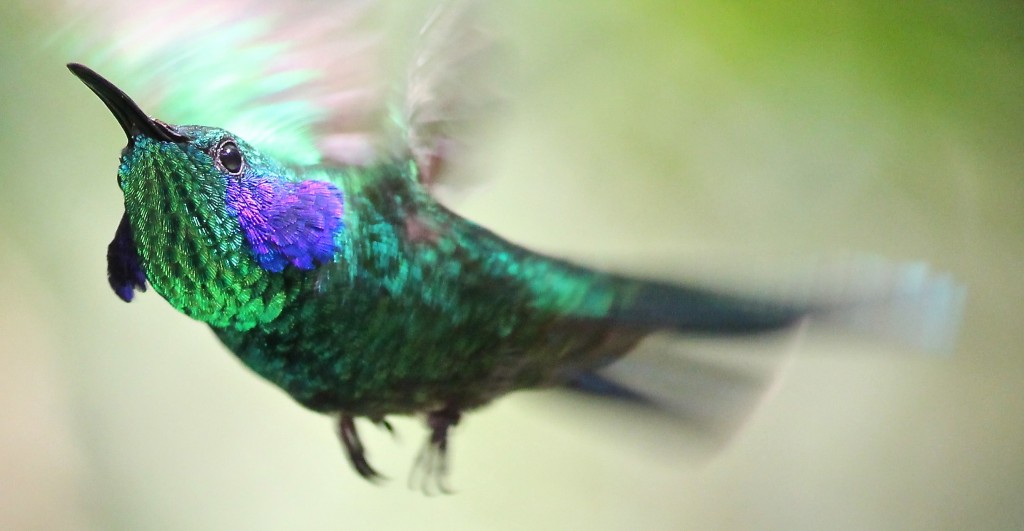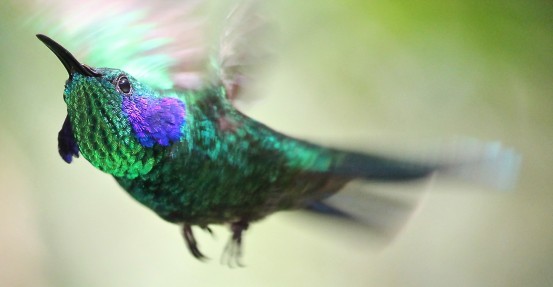

Photo Credit / Dr. Terry Master
By Briana Magistro
SC Staff Writer
Hummingbirds are some of the world’s smallest birds.
In fact, the Bee Hummingbird measures only two inches tall.
They can flap their wings up to 200 times a second, creating the stereotypical “humming” noise and allowing the birds to hover, rather than soar.
This adaptation helps the hummingbird eat. The hummingbird’s diet is mostly nectar, a sweet liquid made of sugars that is excreted by flowers. Excreting nectar is an adaptation in plants to promote pollination.
Both bees and hummingbirds alike are attracted to this sweet food and carry pollen from plant to plant. However, hummingbirds need more than just sweets to stay healthy.
Small insects and spiders make easy prey for these agile predators, and they contain lots of protein, too.
Hummingbirds must eat a lot to support their record-breaking metabolism. Due to inevitable food shortages, hummingbirds have developed a hibernation-like state that slows their metabolism exponentially. This is known as torpor.
Constantly searching for food can also make these birds a bit moody. Studies have observed territorial behavior in hummingbirds in which they chase away other birds from feeders and other food sources.
Even their mouths are shaped for eating! Most hummingbirds have long, narrow beaks, which are perfect for sucking up nectar in flowers.
These birds have developed wing muscles like no other. Observed in studies, the muscle used for the upstroke of the wings is bigger than the muscle used for the down stroke. The strokes cause circular vibrations in the air, which hold up the little bird.
Their flight design is being studied for the possibility to aid in the human flight industry.
Hummingbirds are home in the Americas. Their habitats, including breeding grounds, range from Alaska to the southern tip of South America, including both tropical rainforests and alpine mountains.
Most species, however, are found in the tropics of South America and Central America.
The Green Violetear Hummingbird, for example, can be found from Mexico to mid-South America. It prefers subtropical climates, or cooler forests.
It is mid-sized for a hummingbird, measuring less than five inches tall. It is the fastest recorded hummingbird, reaching a speed of 90 MPH when being chased.
The Green Violetear Hummingbird has been observed as territorial, defending a food source when threatened.
Unlike most birds, hummingbirds are not strong singers. In fact, their tail feathers are louder than they are!
Male hummingbirds will vibrate their tail feathers when courting a female. This produces a loud chirping noise. Males who do not possess proper tail feathers will most likely not mate.
Hummingbirds can live up to 12 years, as recorded by a banding study. This is the longest lifespan of any high-metabolism animal.
The Aztecs worshiped hummingbirds, even naming God after their word for “hummingbird.” They believed that the hummingbird represented vigor and energy.
In addition, their long beaks were viewed as weapons.
Many Americans place nectar feeders near their homes to entice these beautiful creatures.
If you decide to purchase a feeder and artificial nectar, there are a few things to keep in mind: nectar will also attract bees and other insects, and the red artificial nectar found in the garden section of your local supermarket may contain a red dye that is harmful to the birds.
Instead, opt to purchase clear or natural nectar. It is also possible to make it at home by mixing natural sugars in boiling water.
Enjoy these beautiful creatures!
Email Briana at:
bmagistro@live.esu.edu

